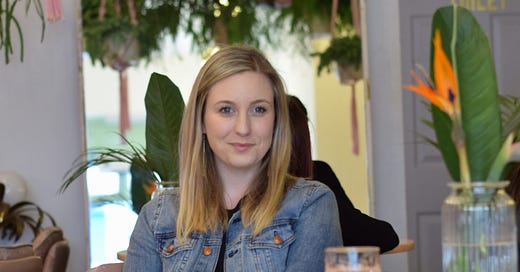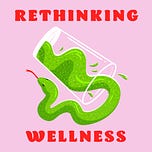The first part of this episode is available to all listeners. To hear the whole thing, become a paid subscriber here.
Registered nutritionist, author, and friend of the pod Laura Thomas joins us to unpack the problematic notion that you need to eat a ridiculously large number of plants per week for gut health, and what we actually know about how plant foods affect the gut microbiome. We also get into how to distinguish good science from hype, how ultra-processed foods have become so demonized despite a lack of strong evidence, how anti-fat bias is baked into the discourse about both gut health and ultra-processed foods, and lots more.
Laura is a Registered Nutritionist who helps people feel less afraid of the food they eat and more comfortable in their bodies. Through her work with individuals and families, as well as in her writing, she challenges dominant ideals about ‘good’ and ‘bad’ foods and ‘good’ and ‘bad’ bodies. She holds a PhD in Nutritional Sciences from Texas A&M University, and worked as a post-doctoral research associate at Cornell University before starting her private practice. More recently she received a diploma in Clinical Nutrition and Eating Disorders from UCL. She has published two books: Just Eat It and How To Just Eat It, both of which focus on healing our relationship with food and our body through Intuitive Eating. Her clinical work is focussed on supporting families to end the intergenerational transmission of body shame and disordered eating. She writes the newsletter Can I Have Another Snack?
If you like this conversation, subscribe to hear lots more like it!
Support the podcast by becoming a paid subscriber, and unlock great perks like extended interviews, subscriber-only Q&As, full access to our archives, commenting privileges and subscriber threads where you can connect with other listeners, and more. Learn more and sign up at rethinkingwellness.substack.com.
Christy's second book, The Wellness Trap, is available wherever books are sold! Order it here, or ask for it in your favorite local bookstore.
If you're looking to make peace with food and break free from diet and wellness culture, come check out Christy's Intuitive Eating Fundamentals online course.
Resources and References
Contains affiliate links to Amazon and Bookshop.org, where I earn a small commission for any purchases made.
Christy’s second book, The Wellness Trap: Break Free from Diet Culture, Disinformation, and Dubious Diagnoses and Find Your True Well-Being
Subscribe on Substack for extended interviews and more
Laura’s previous appearance on Rethinking Wellness
Laura’s episode of Food Psych
Laura’s books, Just Eat It and How To Just Eat It
Laura’s Can I Have Another Snack? newsletter
Laura’s piece about “30+PPW”
Laura’s series on ultra-processed foods
Karen Throsby on Rethinking Wellness
Karen Throsby on Can I Have Another Snack?
Laura’s Instagram
Christy’s online course, Intuitive Eating Fundamentals
Transcript
Disclaimer: The below transcription is primarily rendered by AI, so errors may have occurred. The original audio file is available above.
Christy Harrison: Welcome to Rethinking Wellness, a podcast that offers critical thinking and compassionate skepticism about wellness and diet culture, and reflections on how to find true well-being. I'm your host, Christy Harrison, and I'm a registered dietitian, certified intuitive eating counselor, journalist, and author of three books, including Anti-Diet, which was published in 2019, The Emotional Eating, Chronic Dieting, Binge Eating & Body Image Workbook, which came out on February 20th, and The Wellness Trap, which came out in 2023 and is the inspiration for this podcast. You can learn more and get them all at christyharrison.com/books.
Hey there. Welcome back to Rethinking Wellness. I'm Christy and my guest today is registered nutritionist, author and friend of the pod, Laura Thomas, who joins me to unpack the problematic notion that you need to eat a huge number of plants per week for gut health and what we actually know about how plant foods affect the gut microbiome. We also get into how to distinguish good science from hype, how ultraprocessed foods have become so demonized despite a lack of strong evidence, how anti-fat bias is baked into the discourse about both gut health and ultraprocessed foods, and lots more. Just a heads up that we do mention some specific numbers in this episode in the context of talking about what the science really says and critically examining it.
The first part of this interview is available for everyone and paid subscribers. Get to hear the whole thing, which includes lots more of this great conversation with Laura. To upgrade, go to rethinkingwellness.substack.com. If you do, you'll not only get to hear extended interviews like this one, but you'll also get subscriber only Q and A's, full access to our archives, commenting privileges, and subscriber threads where you can connect with other listeners and more. Plus, you'll be helping to support the show and allow me to keep doing this work. Just go to rethinkingwellness.substack.com to sign up or click the link in the show notes. And thanks so much to everyone who's already a paid subscriber, I couldn't do this without you.
I also want to make sure you know about my second book, which is called the Wellness Trap. The book was the inspiration for this podcast, which I launched to continue the fascinating conversations I had in my reporting. And if you like the interviews here, I think you'll love the book. It explores the connections between wellness and diet culture, how the wellness space became overrun with scams, misinformation, and conspiracy theories why alternative medicine diagnoses like quote unquote leaky gut syndrome and quote unquote adrenal fatigue are misleading and harmful, and how to protect ourselves so that we can find true well being. Just go to christyharrison.com/the wellnesstrap to learn more and buy the book. Or click the link in the show notes. And you can also just pop into your favorite local bookstore and ask for it there.
With that, here is my conversation with Laura Thomas. So Laura, welcome back to rethinking wellness. I'm so excited to talk with you again.
Laura Thomas: Thanks so much for having me. It's great to be back.
Christy Harrison: So we talked about a year ago for Rethinking Wellness, and we've spoken many times before and since offline, but also for my other podcast, Food Psych, so people can check those episodes out if they want to learn more about you and your work and sort of different avenues of your work and research. But for those who don't know you, and I'm sure many do, and you need no introduction, but for those who don't know you, can you just give a quick intro of the work that you do and how you came to do it?
Laura Thomas: Yeah, absolutely. So I'm a UK based registered nutritionist. I sort of have spent a lot of time, a lot of my career working with disordered eating and eating disorders, using a sort of weight inclusive, anti-diet, intuitive eating lens. And sort of more recently, I want to say, over the past five, six years, I've become really interested in, I guess, more the preventative side of things in terms of preventing the intergenerational transmission of disordered eating and body shame. And that's partially coincided with becoming a parent myself. And so I'm really interested in working with parents and families with, particularly mothers who are looking to heal their own relationship with food so that they can help protect their children's relationship with food. And I also do a lot of work in sort of the responsive feeding space. So that's kind of working with the families of children who have feeding differences, whether that's kind of like what we would consider fussy or picky eating or something a bit more extreme than that.
So I feel like I haven't given you a very succinct answer, and it's because I have lots of different interests and I'm kind of really interested in broadly conversations about health and nutrition that sort of influence how we eat and particularly when that might cause fear or anxiety about the food choices that we make and how we feed our family. And so I think that's probably the part that kind of fits into what we're going to be talking about today. And so a big M.O. that I have is to help people feel more comfortable with the food that they eat and more comfortable in their bodies.
Christy Harrison: I love that. That is such a great sort of segue into what we're going to be talking about today, because we both share an interest in gut health and conversations around it and looking at it from a skeptical perspective and seeing how entangled it is with other wellness woo and with fear mongering conversations about food. I'm curious to hear a little bit. About your background in microbiome research, because I've known you for so many years, and it dawned on me recently like, oh, wow, this is a whole part of her career and life that I know nothing about and yet is so relevant to this conversation about gut health and skepticism around it.
Laura Thomas: That's so funny, because I just assumed that people know that this was my kind of first academic career, if you will. So when I was an undergraduate at the University of Aberdeen, a sort of quite well known gut microbiome researcher from somewhere called the Rowett Research Institute, which is folded into the university now. But it was quite a big deal. They started off as actually an animal microbiome sort of research facility. So they were looking at ruminants and sheep and cows, and then they were really on, I would say, like early adoption of microbiome research in humans. And so this researcher came in and spoke to us. I was really, really fascinated as a nutrition student by the idea of the gut microbiome. And so when it came time for us to choose our undergraduate honors research project, I spoke to that researcher and asked if they had any opportunities for me, and they did.
So this is like a three, four month placement that you undertake from sort of the January to the May of your final year and you write your thesis on it. And so, yeah, I went and I studied poop. It was a feeding study. So we were giving people a probiotic yogurt, just a commercial one that you can get in the supermarket, I can get in the supermarket here. And basically we gave it to people for a period of time. Then we sampled their poo before, during and afterwards. And what we saw quite clearly was the DNA from that microbe get introduced into their fecal samples. And then as soon as they stopped eating the yogurt, it disappeared again.
One of my jobs, I remember this so vividly, was standing in the lab trying to culture alive bacterium from this yogurt onto a petri dish, couldn't get it to grow. Now, I don't know if that was my own terrible lab skills at the time, or the point that I kind of want to draw out of that is that oftentimes the products that we're buying commercially, we don't know how viable the bacteria are in them. So anyway, this research project led me to doing a PhD at Texas A&M university, where I was doing similar kind of work in terms of it was the gastrointestinal microbiome. This time we were looking at animal models. I had to collect rat poop from rats at 4 o'clock in the morning for weeks on end. Do not recommend if you can avoid it. And basically we were looking there more at the interaction between the diet that the rat was fed and the sort of prebiotic compounds.
And we can define all of these things as well, if it's helpful. But prebiotic compounds in the rat's diets and then the effect that it had on the immune system and the sort of thesis there was that the gastrointestinal microbiome could potentially mediate the impact that it has on our immune system or on the animal's immune system. So it's a long, convoluted story, but my PhD advisor went kind of off the rails and I ended up switching and sort of starting my PhD research from scratch while in a completely different field. It was more behavioral nutrition, but I've always been really, really fascinated by the gut microbiome. I wrote about this recently, that it's been really interesting to sort of take a step back and watch the sort of hype machine build around the gut microbiome, because actually, when I put my head back into the research more recently, it hasn't really moved on all that much in the sort of 10, 15 years since I was really in that space. And I think that that in and of itself is quite telling.
Christy Harrison: I was looking at the number of studies in PubMed on gut health and gut microbiome, and there's been this huge explosion since the late 1990s, early 2000s. So there's now thousands of studies being published every year. I've sort of had that sense too, that the caliber of the studies isn't really great. It's a lot of animal models, it's a lot of sequencing cells in petri dishes, it's the type of sequencing they're doing on these cells is the methods are even being debated, like 16S RNA or whatever. All these things are still hotly debated in the scientific community and some scientists are saying none of them are really very good for sequencing microbial DNA, and that we might not know a fraction of what we think we know based on these studies.
Laura Thomas: One thing that I found particularly interesting, and I think speaks to what you're getting at here, Christy, is that we've kind of almost come full circle in the way that we approach microbiome research or where we think we need to go. So we started off by culturing live bacteria in the lab to kind of see what they do and phenotype them. Then there was this huge boon in genomics and bioinformatics, and so we were able to kind of get into the sequencing. Sequencing became a lot cheaper, so we could extract RNA and DNA and figure out exactly who was there. The problem is now that we don't really know what they're doing, so we kind of have a sense of who's there, but we don't know what they're doing.
And so we actually have to go back to the culture techniques that are hundreds and hundreds of years old to find out functionally what those bacteria and yeast and other microorganisms are doing in the gut. And so, yeah, we've had this really completely full circle moment because we have more of a sense of who's there. But again, we don't know what they're doing, and we don't know how important that is, and we don't know where exactly they are in the gastrointestinal tract, which is another kind of thread that scientists are kind of tugging on to figure out where do we need to sample along the gastrointestinal tract.
It's huge. It's really, really long, and we're only taking samples from feces, from poop. But that poop is not representative of what's going on in the seacum and higher up, towards the end of the small intestine and the beginning of the large intestine. And those ecosystems all along the gut are so completely different from one another. I was talking about this on my podcast recently. One part of, if we think of the gastrointestinal tract having lots of different sort of ecosystems all the way along it, you could have a tropical rainforest at one end and sort of English country garden at the other end. Those are very different ecosystems, but we're only looking at sort of what's coming out one end.
But there is some really fascinating research that is inviting people to swallow capsules which sample all along the length of the gastrointestinal tract, which is. I don't even understand how that technology works, but it's really cool. And I think we're going to see, there's going to be some revelations, I think, that come out of that research in the next five to ten years.
Christy Harrison: Well, and the timeline on this is so long, right? It's like five to ten years for interesting revelations that are about the human microbiome, gut microbiome, and then probably a lot more years to really figure out what can we do with this information, right? What does it mean for how people eat or other components that go into the gastrointestinal microbiome, like stress and exposure to different substances and all the rest? But the hype machine, we've both talked about this, how the hype has gotten so far out ahead of the science, right? And that the hype was making people think that they can do things to hack their gut microbiome now to make themselves supposedly healthier.
And there's a lot been written in the popular press and based on sort of early stage research about ratios of particular types of bacteria one to the other, and how that is supposedly linked with body weight. And then a few years after that became so overhyped and stuff, it became clear that actually that doesn't really seem to be the case. And that what we thought we knew about the ratio of different bacteria to one to the other doesn't really have any impact on weight. And this is all so out there in the popular imagination that your gut microbiome has so much to do with your weight, that your gut microbiome has to do with every aspect of health, from physical health realms that don't even touch the gut, but that have gas, like cardiovascular health or whateverevity and all that stuff.
Laura Thomas: A lot of mental health stuff.
Christy Harrison: Right. And the gut brain connection or the gut brain immune connection and all these different things. Right? So given all that hype and sort of how far ahead the press, the popular press and sort of the popular wellness culture imagination is, how far ahead all that's gotten of this actual science, what do you think people should know about that, first of all? And then what are some of the implications of all this hype on people's relationships with food and people's well being?
Laura Thomas: Yeah. So I think, like, I kind of touched on a little bit the way that gut health has been captured in the popular imagination has completely leapfrogged, I think, in my opinion, at least where the science is and what the science can actually reveal to us at this point. And don't get me wrong, I think that the science is absolutely fascinating. I think it is incredible that there are all of these communities of bacteria and other microorganisms living in and on our bodies. I think that's so cool from just, like, a nerdy biology perspective. But I also think that the way that we talk about the potential that the gut microbiome has on our health is massively overstated. I think it's probably a much, much smaller effect than most people think that it is. There are some exceptions to that. Fecal transplants, for example, might be really important for treating particular conditions, but those are clinical medical applications, not the kind of gut health in inverted commas.
Christy Harrison: And not the DIY fecal transplants at home by people who are just biohacking or whatever.
Laura Thomas: Yeah, they are not for an otherwise healthy person. They're in usually quite acute situations. So, yeah, I think there's kind of like, just a leapfrogging of the science. I think that the effect or the magnitude of the impact that the gut microbiome has on our health is a lot smaller than we kind of colloquially understand it. And I think what ends up happening is that this kind of hype machine around gut health has inadvertently obscured other determinants of, first of all, gut health, which we could maybe talk about sort of on an individual level, but on a sort of social level, it completely glosses over the social and structural determinants of health, and kind of, I think, foregrounds this idea of personal responsibility, that we're all individually responsible for taking care of our gut garden, or whatever people call it. That's a real thing that people say. So kind of has that impact.
And the one that you and I are both familiar with through our clinical work, is the anxiety and the apprehension, the sort of micromanagement that can end up happening when we are really, we have this myopic focus on our guts and gut health, and the way that that can lead to or exacerbate disordered eating, which leads to worsening gut health symptoms. And you can get into this really nasty spiral where the things that you are doing to sort of, quote, unquote, look after your gut health end up causing more symptoms, which then cause a doubling down of the so called treatments, which just gets into this really sticky cycle that's hard to break.
Christy Harrison: I think one area of obsession, and one way that people get so taken away from peaceful relationship with food in their bodies, in the gut health realm, is this notion of 30 plus plants per week, right, that you're supposed to eat, or it's 30 plus PPW, as the TikTok girlies are calling it, right? Supposed to be like, you have this optimal microbiome diversity if you're eating that number of plants, whatever that means. You wrote a piece recently about this, about where this notion came from, which I had been so curious about for a while and was added on my long list of things to write about and then was able to check it out.
Laura Thomas: Sorry I pipped you to the post.
Christy Harrison: I appreciate it, because I was dreading that, because it just seemed like such a deep dive.
Laura Thomas: It was a whole thing.
Christy Harrison: A whole thing. And you did such a thorough and amazing job of reporting on it. So we'll link to the post in the show notes for this piece, but I'd love to dig into that a little bit. Where did this idea originate? And is it really evidence based, or is it another example of the hype machine just getting way far ahead of the science?
Laura Thomas: So it's really, really interesting because there is some science to it and it's a really interesting study. But it's one single, solitary study, which, as you and I both know, is not the burden of evidence that means that we can completely throw out the five a day recommendation and replace it with this 30 plus plants per week recommendation. So it's got completely mangled up in the hype machine. I see a lot of brands here in the UK now using it as part of their marketing, which I think is really, really sneaky, because you can have, in theory, you can have ten plus plant based ingredients in a product, but it doesn't constitute even one portion of fruit and vegetables if we look at it by weight. So there's some really sneaky, like, I think, pulling the wool over people's eyes that I've noticed, at least.
Going back to the actual study. Okay, so this study is a really cool initiative called the American Gut Project, or it was called the American Gut Project. It's now known as the Microsetta initiative. And it's a sort of open source citizen science study whereby people pay a small fee to access a fecal testing kit, and then they send away their sample and they get a readout that tells them the sort of relative proportions and the different genus of bacteria and other microorganisms that are living in their gut and kind of just lets them know what their gut looks like relative to the other people in the study. And then the researchers use this information to kind of just understand the sort of length and breadth of the human microbiome. Right.
This study is a lot bigger than some other studies, and so they've been able to document much more variety in what and who is in the micr obiome or the microbiota, I should say, compared to some other studies that have gone before it. So it's a really interesting study, and I love the sort of open access, citizen science aspect of things. And I think that's a cool model. But I think, first of all, just by virtue of the fact that people have to, they're not paying to participate in the study, but they're paying to cover the cost of the materials, I can't remember exactly how much it is. I want to say it's like $90 or something. So it's not an insignificant amount of money. And so already you are biasing the sample. Right. It's open source, it's citizen science. You don't have a representative sample there straight off the bat. Okay.
So I think that's one thing to keep in mind. Basically, what this study did was, as well as taking the fecal samples, they also asked people to complete a questionnaire about how many plant based foods they ate on a given week. And they kind of give the example of, like, if you have a can of soup and it has tomatoes, onions and carrots in it, I don't know what kind of soup this is. Like, it's a minestrone or something like this. And that would count as three different plant based ingredients.
Okay? Doesn't mention anything about spices, doesn't mention anything about quantities. It just says, count each single plant food as a separate food, more or less. And then it asks people to pick if they eat zero to five, five to ten, and then all the way up to sort of like 30 plus. And then what they do in this study is that they separate out the people who eat more than 30 plants per week, according to this self report, which we've already established is a bit shaky. And then on the other hand, the people who eat less than ten plants per week. I always want to say 30 plants per day, which is even more. I'm sure some people are trying to go for that, but I've seen these recipes on TikTok that are like, this salad has twelve different plants in it. And I'm like, please eat something other than salad. But anyway, if you just eat that salad, babe, you're not going to meet your nutrition requirements.
Christy Harrison: Definitely not.
Laura Thomas: So back to my point. They're comparing people who eat more than 30 plants versus less than ten plants. And they also looked at people who self reported as being, like, vegetarian, vegan, or had an omnivorous diet. And they found that compared to those other categories, those like diet label type categories, that if people reported that they ate more than 30 plants per week, that that kind of correlated more strongly with more diversity. And so these kind of like gut health gurus have taken that little tidbit and extrapolated it to mean that everyone should be eating 30 plus plants per week for optimal gut diversity.
Christy Harrison: And diversity typically gets conflated with gut health. Right? I mean, it seems to be that there's a correlation, perhaps, between greater microbiome diversity in the gut and better health outcomes on certain measures. But in the gut health world, in this corner of wellness culture that's devoted to gut health, it's sort of just substituted one for one. Diversity equals health.
Laura Thomas: Yes, that's a really reductionist sort of interpretation of that finding, but that's not what the study found. The study looked very specifically at a group of maybe or a family. They were looking predominantly at bacteria that had a gene that coded for short chain fatty acid production. So these are things like butyrate and acetate and proprionate, which we do believe to have a protective effect, particularly against colorectal cancer, for example. This is where it comes back to what I was talking about earlier in terms of the functional aspects of the microbiota. So we know back that those butyrate producers are there. We don't know how active they are, we don't know how much butyrate they're producing, because we're only looking at. I think in this case, it was the 16S DNA could be wrong. Don't quote me on that bit. But they were looking at the sort of genetic fingerprint, rather than measuring directly butyrate, as I understand it, basically, they were looking at the sort of fingerprint, and then that has been extrapolated to mean that there's overall gut diversity.
What we can say is that there was maybe diversity in terms of that particular function. But there are so many other functions that the microbiota perform within the gut, whether that's producing nutrients, whether that's digesting particular dietary compounds. There are a ton of different functions within the microbiota. So just because we have diversity within one functional group does not mean that there's overall functionality. And what the research seems to be suggesting, or what scientists at least are trying to tease apart now, is what is more important, is it diversity in a kind of holistic sense of diversity, or is it functional diversity? And I don't think we know that quite yet. But back to this study. It's had this very specific finding. It's not an uninteresting finding, but it is very different from the broader interpretation of that message.
Christy Harrison: Right. Which has gotten so specific and so applied clinically, like, to individuals saying you need to do this for optimal gut health. Another issue you pointed out with this study is something I see all the time in nutrition research and just drives me up a wall, which is that researchers will compare people at the highest end and the lowest end of the spectrum of intake for particular foods. Or particular nutrients, and then use that to make inferences about the health impacts of those foods, even though people in those groups also differ in other really significant ways. And observational nutrition research rarely controls for them, rarely controls for things like socioeconomic status, education, access to health care, like all of that stuff that has such powerful effects on health outcomes and also differs between groups who are eating less plant food and more plant food, for example. And then there's also the confounding factors like weight stigma and disordered eating and weight cycling, which are almost never controlled for. I've almost never seen.
Laura Thomas: Almost never.
Christy Harrison: So in this case, they compared people who ate ten or fewer plant foods per week with 30 or more plant foods per week. And the people who are eating at those extremes probably have very different lives in many ways. So can you talk a little bit about that and sort of what this study might or might not be controlling for in that regard?
Laura Thomas: Yeah, I think it ties in with what I said earlier in terms of when we are kind of focused on the minutiae of detail, like how many plant based foods are being consumed, we're missing these bigger, broader structural and social determinants of health. So this particular study, I think it used maybe education and socioeconomic position as a sort of proxy for some of these social and structural determinants of health. But they're only going to explain some of the variance between the two groups. There are going to be a lot of invisible or confounding variables that just haven't been taken into consideration. Taken into account. Anti-fat bias, racism, ableism, ageism, even all of these things aren't being directly controlled for in not just this study, but in, broadly speaking, in nutrition research. So all of those things, they have such a bearing on how we move through the world.
And so it's one thing to say, okay, for optimal gut health, if we sort of buy into that, which we've just established is kind of resting on shaky ground. But even if we were to buy into that, then it doesn't help us kind of address all the structural ways that 30 plus plants per week is just not accessible to so many people for a wide variety of reasons, even from sort of quite fundamental clinical reasons, from the perspective of if you've got intestinal failure, if you have Crohn's disease or another inflammatory bowel disease, then depending on the advice that you're getting from your dietitian, that might not be appropriate for you, all the way through to shopping for and preparing and literally just accessing those foods, that's a near impossibility for some people. It's obviously incredibly expensive as well, an elitist.
And I'm also thinking about it as a parent. There's no way in hell my kid is eating 30 plus different plant foods when they're going through that very specific food neophobic phase between sort of the ages of three and five. And it just adds a ton of pressure onto, I think, particularly parents who are probably going to feel quite stressed about how many fruits and vegetables their kids are eating anyway before adding on this imperative to eat 30 different kinds each week. And I know that advocates will say, well, it could just be a pinch of a herb or a pinch of a spice or a cup of coffee, that all counts. That has not been empirically tested. So when they are saying that, they are pulling it out of their ass, because as far as I'm aware, there's no research to suggest that.
Christy Harrison: Right, because it seems like the American Gut Project doesn't even distinguish what counts as a plant, right? Yeah. Or what people are counting. It's just sort of leaving it up to people to count it themselves. I mean, this dovetails with the conversation about ultra processed foods that I want to have with you, because you've written a lot about ultraprocessed foods and how those have become so demonized. And I'd love to talk about how that conversation intersects with the discourse on gut health. But before we get into that, can you just give us an overview of what ultraprocessed foods are and why there's so much talk of them lately?
Laura Thomas: So ultraprocessed foods are a term that sort of developed, I think it was first appeared in the nutrition literature in about 2009, and different researchers have kind of tried to define it in different ways. But the most commonly used classification system for ultra processed foods is something called Nova. And that was developed by a researcher called Carlos Monteiro in Brazil and his research team at, I believe, the University of Sao Paulo. And basically, he came up with this classification system to stratify foods into four different groups. So group one is unprocessed or minimally processed foods. So I think of that as food that pretty much comes straight out of the ground, or it comes from an animal or a fungus, and it hasn't really had much done to it. So it's an apple that you pick off the tree. It's a carrot that you would pull out of the ground. It's an egg that was laid by a chicken. Those would all be considered unprocessed foods.
And then within that group one, you have this minimally processed food subcategory, which are those unprocessed foods that have gone through some sort of processing. Like, it could have been dried, it could have been fermented, it could have been roasted. So coffee is a perfect example of one of these minimally processed foods. Okay, so that's your group one, unprocessed or minimally processed food.
The next group is group two are called processed culinary ingredients. So it's anything that's kind of pressed or ground or milled. It could be butter, for example, or sugar, honey, maple syrup, salt. These are all examples of processed culinary ingredients. Right? So they might have come from. So, for example, sugar comes from sugar cane. Sugar cane would be a minimally processed food. Although you can't eat sugar cane as straight up sugar, the refined product would be considered a processed culinary ingredient.
Group three are considered processed foods. This is where I think it gets interesting, because the word processed food is just thrown around with abandon. But from a technical perspective, it is group one plus group two foods cooked together. So if you go to the farmer's market and you buy fresh bread from your farmers market, that's a processed food. If you make cookies at home from scratch, that's a processed food. If you go to your Italian nana's house and she makes lasagna, that's a processed food. Basically, everything we eat is a processed food. Right? It's undergone some processing. So it's group one plus group two foods together.
And then group four are what is considered ultraprocessed foods. Now, the way that they define it in some documentation is as a formulation made mostly or entirely from substances derived from foods and additives, with little, if any, of that intact group. So this could be a whole range of different things. It could be everything from whey from milk, to gluten from wheat and rye to kind of coloring, flavoring, stabilizers, a whole host of things that we would consider sort of food additives, like E numbers.
But the way that they define it in the sort of Nova documentation is that it's a food additive that is intended to imitate or enhance the sensory qualities of foods, or disguise unpalatable aspects of the final product. So you can see it's a really vague definition that could cover a lot of things. And in my series on ultraprocessed foods, I use the example of this oat bar that my three year old loves. I think they're disgusting, but he loves them. It's kind of like a flaccid granola bar is, like, the best way that I can describe it. So it's mostly oats, but it has concentrated fruit juice in it. And concentrated fruit juice is considered an ultraprocessed food. So even though this bar is comprised mostly of oats, because it has this ultra processed ingredient in it, it would overall be considered an ultra processed food, even though that kind of flies in the face of what the actual definition says.
Carlos Montiaro has been on the record as saying that you can identify an ultra processed food by having at least one item characteristic of the ultra processed foods group. He's basically given us something to try and easily identify an ultraprocessed food. But by that definition, sparkling water would be an ultraprocessed food. If the bar is that it has to have one ingredient that is characteristic of the ultraprocessed food category, then it's very difficult to find something in a supermarket that doesn't meet that criteria.
Christy Harrison: I mean, I'm sure everyone listening knows how demonized ultraprocessed foods are in the mainstream imagination. And we don't need to get into all the ways that shows up, because I think people have probably experienced that and may have some of their own hesitations or fears around ultraprocessed foods. But I think, especially when it comes to gut health, there's some really interesting crossovers or connections there, and there's some arguments being made against ultraprocessed foods in the name of gut health that are really problematic. And one thing I think that the discourse on ultraprocessed foods and gut health have in common, as in a lot of nutrition science as well, is that fear mongering headlines and social media trends, again, have gotten way out ahead of the science. And there's this connection being made to sort of demonize this food that has had a sort of negative valence for a long time, but demonize it in a new way, right? It's like, "Oh, now this is the reason we should be afraid of it." So I'd love to hear your thoughts on that and how much we actually know about ultraprocessed foods in general, and their interaction with the gut microbiome in particular.















